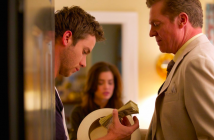
Lost River (2014)
Cast: Christina Hendricks, Iain De Caestecker, Matt Smith
Director: Ryan Gosling
Country: USA
Genre: Drama | Fantasy | Mystery | Thriller
Editor’s Note: Lost River is currently playing in limited theatrical release.
Ryan Gosling’s debut feature Lost River shows promise, ambition, and a set of keen ideas which the potential is not fully realized on screen. Though the film has been critically dismissed as a failed attempt at art-house cinema, there is much to be admired in Lost River, particularly Gosling’s adept stylistic impulses. The atmosphere in which he captures sadness, loneliness and emptiness is both fascinating and haunting, sure to leave you hypnotized long after the film’s close.
Ryan Gosling’s debut feature Lost River shows promise, ambition, and a set of keen ideas which the potential is not fully realized on screen.
Visually, the film is not to be overlooked. Though there are many awkward moments that cringe of amateur hour, Gosling and DP Benoit Debie (Enter the Void, Spring Breakers) create a world in Lost River that is unlike anything else. Through hand cameras, filtered lighting, and a very wide-angle lens, Lost River if anything creates a unique and intriguing atmosphere for the events that take place. For this reason, the film will likely gain cult success, as its surrealist nature will surely engage some viewers.

Gosling’s stylistic impulse is noticeable in the first shot. Saturated in orange and reds, a vehicle passes a little boy mumbling to himself. 80s music begins as he walks forwards. Slow motion follows him into a forest where his mother is seen in high exposure. A montage of the two boys, their mother, and their vacant town follows until the song reaches its climax. The visuals are punctuated by key lighting and sharp contrasts which may recall the films of Nicolas Winding Refn, who directed Gosling in his last two films, Drive, and Only God Forgives.
Lost River is undoubtedly highly stylistic with a thin and veiled plot that remains somewhat ambiguous and unsettling until the end. Years ago, a city was destroyed intentionally by flooding to create a reservoir. A curse was put on the town surrounding it: Lost River, a place that feels like it’s suffocating under water. Billy (Christina Hendricks) and her two sons live in Lost River under the threat of eviction. Billy accepts a depraved position in a place of entertainment to make rent, while Bones (Iain De Caestecker) searches a way out of the hell-hole they are in.
…. the hyper editing creates a disorderly and dysfunctional visual rhetoric, holding the film back from truly conveying said themes.
From beginning to end, Debie and Gosling implement jump cuts and slow pans to create a somewhat ominous and discontinuous tone. At times, their efforts recall Terrence Malick, but rather than support the films’ themes, the hyper editing creates a disorderly and dysfunctional visual rhetoric, holding the film back from truly conveying said themes.
The dialogue, too, is intentionally a bit cryptic and ominous. This makes the film at times quite difficult to follow. It lends the film’s energy a certain sense of mystery, which is surely what Gosling is going for, but it also takes away from the film’s substance, making its stylistic features appear shallow rather than meaningful. What further delimits Lost River’s depth are the sound effects. While the haunting soundtrack boasts a number of hauntingly beautiful songs, making it one of the film’s best features, the sound editing is composed mostly of ominous tones rather than actual melodies. Though there are several great songs in the film,—Lost River’s best scene shows a young girl in pink filtered lighting singing a haunting song about love—most of the film incorporates a cheap foley work, made for TV special type soundtrack. When Billy falls asleep in the taxi and the film cuts to black, vision returns with a “pop/boom” synthesizer tone to increase the affect of the moment she wakes up. Instead it just makes the moment extremely cheesy, and as mentioned, delimits the films visual depth. Essentially, the scene is shot well and then ruined by poor post-production editing, as much of the film seems to be.
With Lost River, Gosling is certainly trying to create a personality for himself. He attempts some innovative activities such as avoiding shot-reverse-shot editing by utilizing more than two cameras, using visual metaphor to tell the story, and using sound bridges effectively to create transitions between scenes and convey relations between characters. At times, his innovations are admirable, and I for one applaud Gosling’s ambitions, though many of the scenes unfortunately appear awkward. Surely it’s a matter of finding his own charm, and if he keeps at it, Gosling is sure to create something more widely acclaimed in the future.
Though the film has many faults, Lost River’s atmosphere of sadness, loneliness and emptiness is both fascinating and haunting, sure to leave you hypnotized long after the film’s close.



